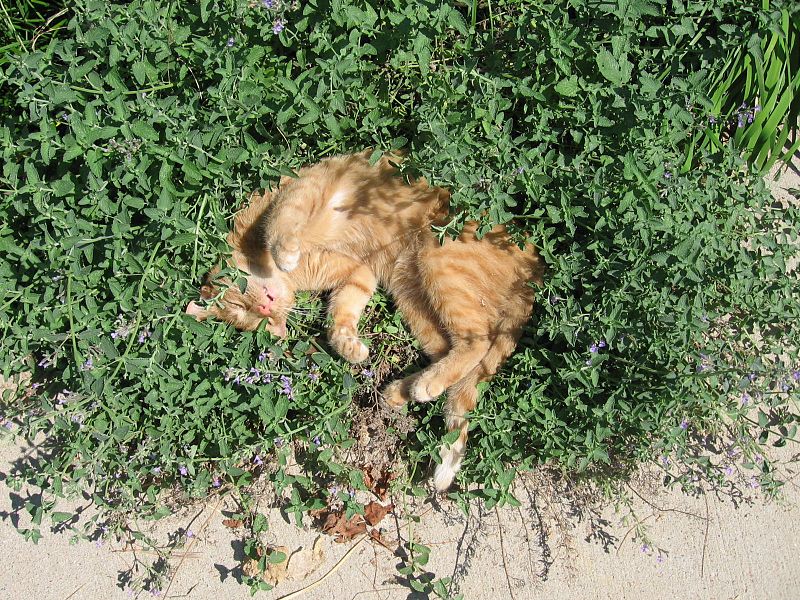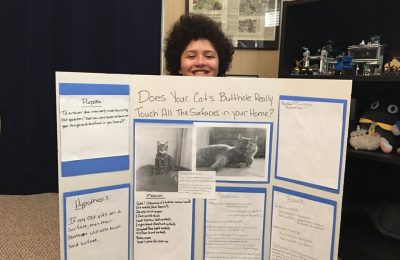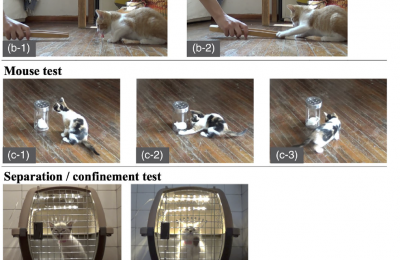Catnip: almost everyone knows about this magical mint-relative that has a powerful effect on approximately 60% of cats. Rolling, rubbing, drooling, and chewing are just a few of the responses your cat might have to catnip. But most folks, including veterinary professionals, aren’t aware that there are other plants that have a similar, usually positive, effect on our kitties.
A new study with a long title, Responsiveness of cats (Felidae) to silver vine (Actinidia polygama), Tatarian honeysuckle (Lonicera tatarica), valerian (Valeriana officinalis) and catnip (Nepeta cataria), took an in-depth look at how these catnip alternatives, such as silver vine or Tatarian honeysuckle rank next to been-there, done-that catnip. IT’S OPEN ACCESS!!!!
Lead author Sebastiaan Bol was kind enough to answer some of my questions about their work.
The investigators tested the effects of catnip and the three alternative substances on cats in a sanctuary, a shelter, and a veterinary office. Not wanting other felines to feel left out, they also looked at whether tigers and bobcats would indulge.
Olfactory enrichments were presented to cats in a clean sock. To be certain that cats don’t just love socks, a control sock with no plant product was also given to the cats. Responses such as sniffing, licking, head shaking, rubbing, and rolling were noted, and cats’ responses were classified as either “mild/partial,” or “characteristic/intense.” Dr. Bol told me more about what these responses looked like:
“Cats showing the characteristic catnip response almost always first sniff and lick, then give the sock chin or cheek rubs and start rolling. A positive response needed to last at least several seconds before it would be considered an intense response. We observed that not all domestic cats responded to the plants the same way; some would only sniff and lick. These cats really seemed to enjoy the plant material though and it was a response we did not see when they were offered the negative, empty control sock.”

The results of the study showed that not all plants are equal to cats. Over three-quarters of the cats responded to silver vine, 68% to catnip, 53% to honeysuckle, and 47% responded to valerian. There were no effects of sex or personality (classification as shy or outgoing) on the response. There were more mild than intense responses overall for catnip than for silver vine, especially with older cats, suggesting an effect of age on the catnip response.
The good news is that most cats will enjoy some type of olfactory enrichment. Ninety-four percent of the cats responded to at least one stimulus, and 24% responded to all four! So, if you’re not offering olfactory enrichment for your cat, don’t you think it’s time to try?
If you don’t have a local source of silver vine, Bol recommends purchasing the powdered version from Smack, a Japanese company that ships through Amazon (give it a few weeks to arrive). “If their cat doesn’t respond euflorically to this, it is unlikely they will respond to silver vine wood sticks. When they do respond (to the powder), it is worth trying the sticks. Hold the wood sticks in front of your cat to make it easier for them to give it cheek rubs. When the wood lays on the floor, it is much more difficult for your cat to interact with it. In contrast to the powder, not all cats will respond positively to the wood sticks immediately.” Bol felt that their study showed less support for the use of silver vine leaves, although I have to say that my backyard feral, the Town Crier, begs to differ.
But what about the big cats in this study? Previous research has suggested tigers don’t much care for catnip. Only one of nine tigers responded mildly positively to catnip, and none responded positively to the silver vine: four were indifferent and five walked away from it.
All of the bobcats showed a characteristic response to silver vine and catnip, showing similar behaviors as those of our “tiny tigers.” I asked Sebastiaan what is up with tigers not loving the ‘nip.
“Interestingly, we still have no idea which genes are involved in the catnip response. Genetic variation within a species determines if the animal has the ability to respond to a certain active compound, but that’s pretty much all we know. I believe the difference between the response of domestic cats and tigers to the plant materials can be explained by their different genetic makeup. Once we have identified the gene or genes involved in the catnip response, it would be very interesting to compare them between different species in the Felidae.” Agreed!
Having observed some cats getting riled up on catnip, I asked Dr. Bol if he observed any negative responses to the olfactory enrichments. “I don’t think there is something inside the plants that causes aggression. Each cat will respond differently to the plants. Some will mellow out, others become more playful. We have seen cats that play rough when offered the plant materials. They are just terribly excited, but mean no harm.” He recommends, “When you live with multiple cats, make sure you supervise your cats the first few times you offer them these materials, so you know how it affects their behavior. Never give some to one cat, but not the other(s). If your cat becomes really excited, just don’t pet them while they are enjoying the plants. There will be plenty of time to cuddle with your cat afterwards, when they are tired from playing.”
Overall, this is a lovely study that is one of the most comprehensive to date at categorizing cats’ responses to olfactory enrichment. My only critique is that this study could have been strengthened by blinding the coder to which treatment the cat was receiving. However, this research provides a compelling case for why we should offer a little “herb” to our cats. These plants may increase activity and mental stimulation, or be useful as rewards in training; or perhaps most importantly, provide cats with a welcome sense of “eufloria.”
Reference:
Bol, S., Caspers, J., Buckingham, L., Anderson-Shelton, G. D., Ridgway, C., Buffington, C. T., … & Bunnik, E. M. (2017). Responsiveness of cats (Felidae) to silver vine (Actinidia polygama), Tatarian honeysuckle (Lonicera tatarica), valerian (Valeriana officinalis) and catnip (Nepeta cataria). BMC veterinary research, 13(1), 70.



